5 popular image upload services overview
Last edited:
There are many file uploading services that help you upload, manage, transform, and deliver images and other files to end users. If you’re looking for Cloudinary alternatives, or you’d like to learn more about Uploadcare competitors, this article will provide you with the relevant information, all in one place. It’ll be useful for people who are looking for an image uploading solution, or who already use one and want to know if there are better alternatives.
Determine your business tasks
Let’s say you have lots of images for your website and you need to upload them to an optimized storage so they load fast. Another popular case is that you want your website users to be able to upload profile pictures and other images. Whatever your business task is, uploading is the first step of the process.
File uploading is a technical task that implies that the uploaded files (e.g., images) will be accessed or viewed later. Nobody wants to upload images just for the sake of uploading. However, uploaded images need to be stored, delivered, modified, adapted, etc. In other words, this step is just the tip of the iceberg in a complete solution.
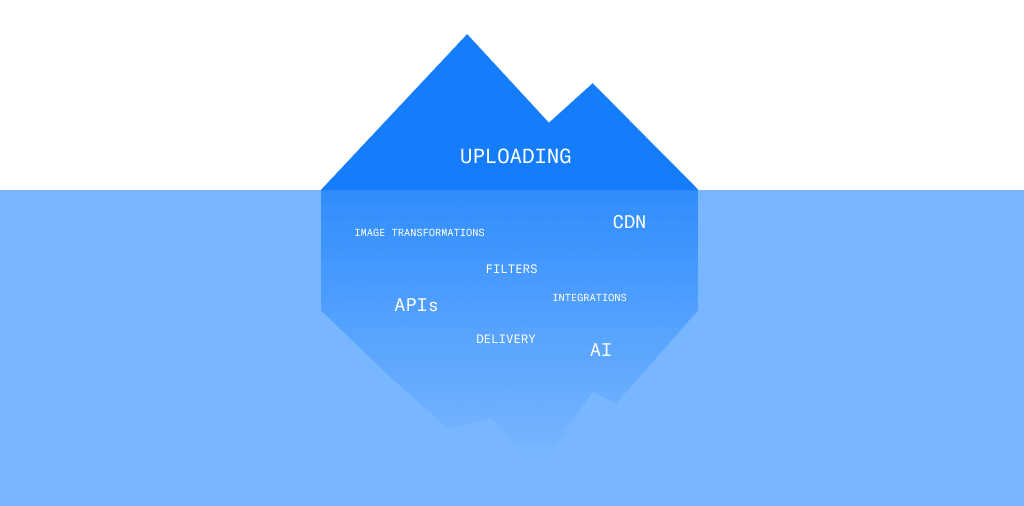 Uploading is an important yet superficial part of your image lifecycle
Uploading is an important yet superficial part of your image lifecycleIn this article, we decided to review five popular file uploading services that you’ll find on the first page of a Google search:
- Uploadcare
- Sirv
- Cloudinary
- Filestack
- Transloadit
All of these services help you upload, transform, and deliver pictures, but they were designed with slightly different purposes in mind, and in order to pick the right tool, you first need to determine your business tasks.
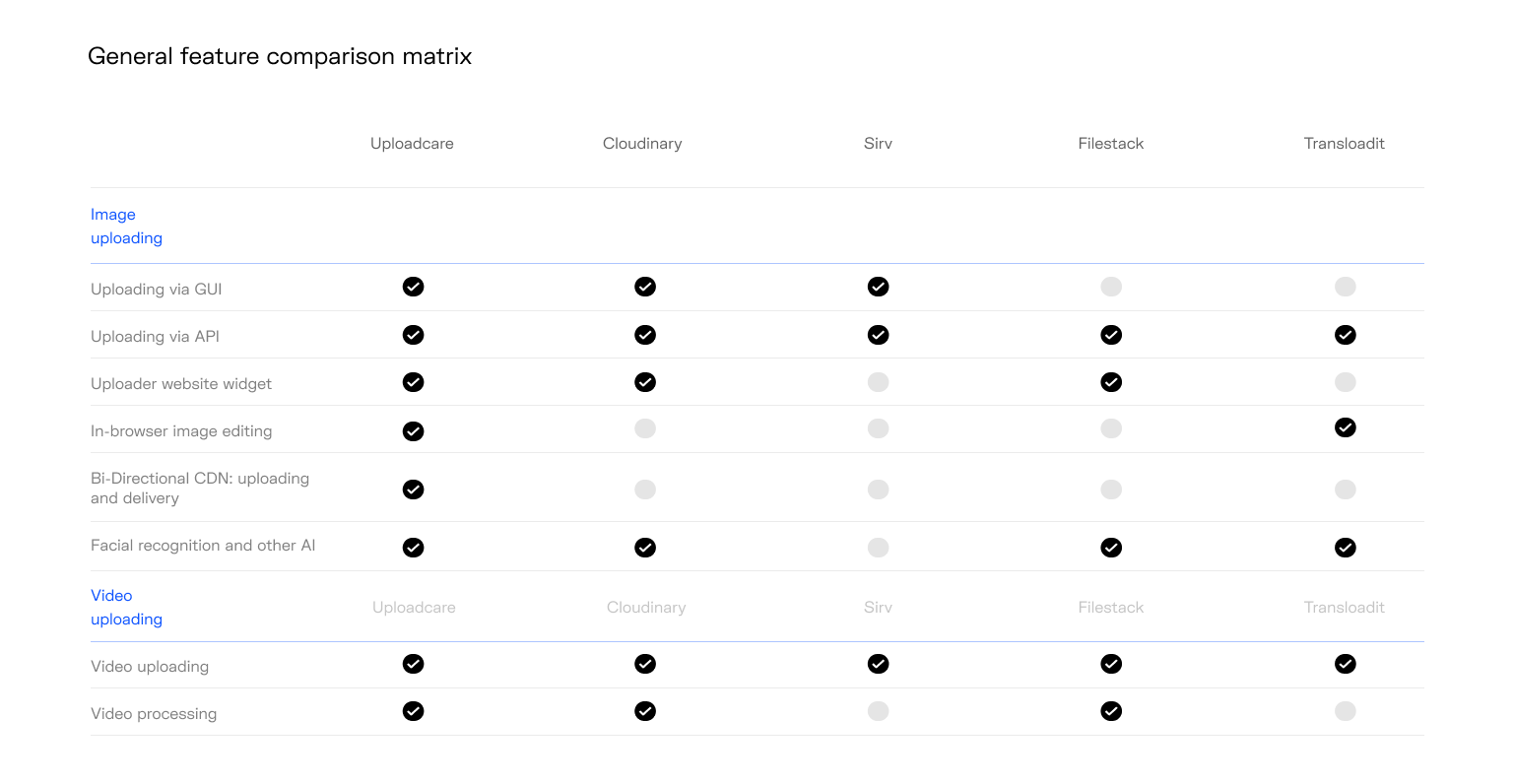 General feature comparison chart
General feature comparison chart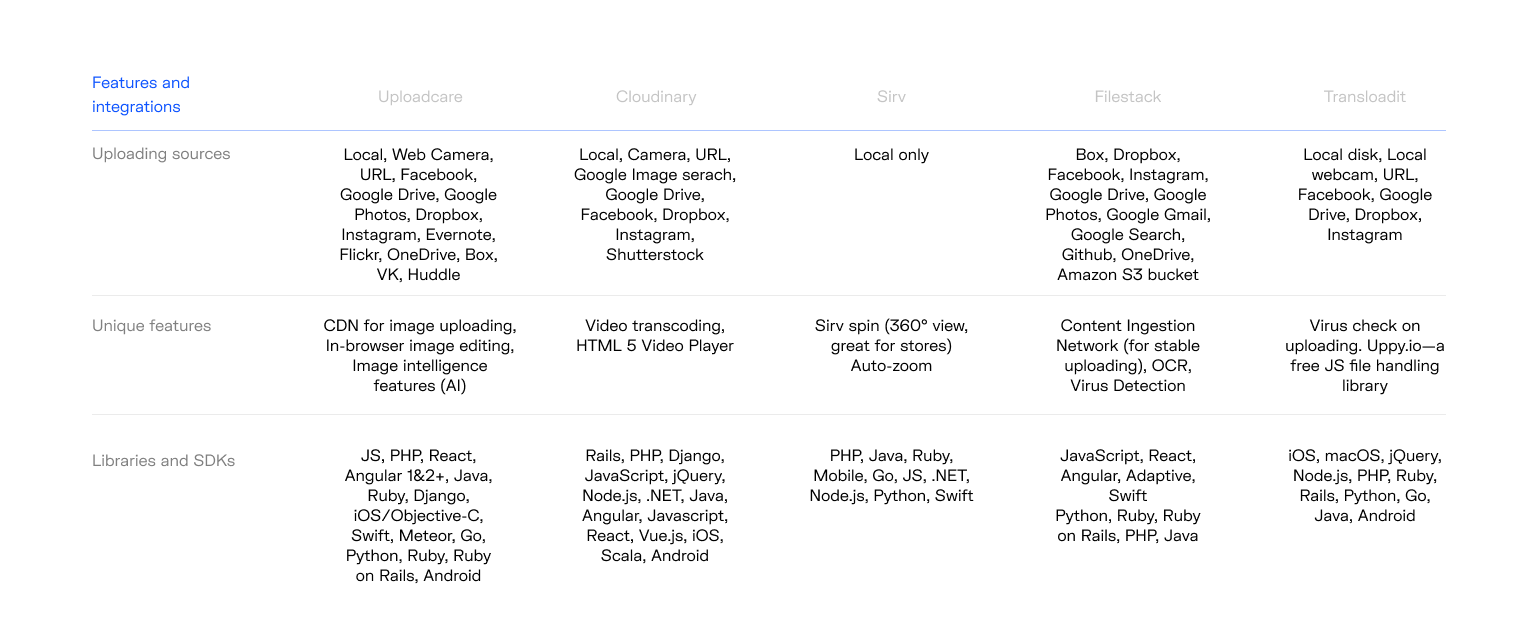 General feature and integration comparison chart
General feature and integration comparison chartClick to open in a new tab
1. Uploadcare
Uploadcare lets your online business upload files of all types, but it’s superior for images with its advanced tools for image transformations and delivery. File uploading is the first, yet most important part of a complete pipeline:
 Uploadcare image pipeline. Upload, storage, transform, intelligence, delivery
Uploadcare image pipeline. Upload, storage, transform, intelligence, deliveryAll of these components are available out of the box for all plans.
As for the uploading process, there are a few major advantages:
- Bi-directional CDN for faster uploading
- File Upload module for website embed with in-browser editing (crop, filters, etc.)
- AI for smart crop and smart blur after uploading
Uploadcare started as a service for developers in 2012 without a dashboard GUI; all features were accessible through an API. In time, it got native integrations with popular platforms such as Node.js, React, Ruby, Python, PHP, Java, etc., and developed its visual side and user-friendliness.
Now, as of 2020, it’s a complete ecosystem for file management with a GUI. You can upload and manage images, videos, documents, and other files. Plus, it has advanced methods to manipulate images.
Bi-directional CDN and faster uploading
Here’s how you and your end users can upload images:
- Upload images through the Dashboard (UI) — the simplest option, great for trial and testing.
- Embed an uploader widget into your website so your users can upload their files and profile pictures.
- Use JS API methods if you want tighter integration of the uploader with your app.
Uploading is faster thanks to the bi-directional CDN for file uploading. Bi-directional means that it works both ways not only for image delivery, which is a standard feature for every other solution, but also for uploading as well — this is unique. The delivery network includes 288k+ nodes worldwide.
File uploader
Implementing a file uploader on your own would take months (even years, with the infrastructure behind the uploader). If you choose Uploadcare as your image management solution, you’ll get a responsive file uploading module that can be easily embedded into your website and blended with its color scheme and styles.
The file uploader has an in-browser image editor where you can crop, resize, and do other edits on the files you’ve just uploaded. The widget’s look can be fully customized with custom CSS to match your corporate style.
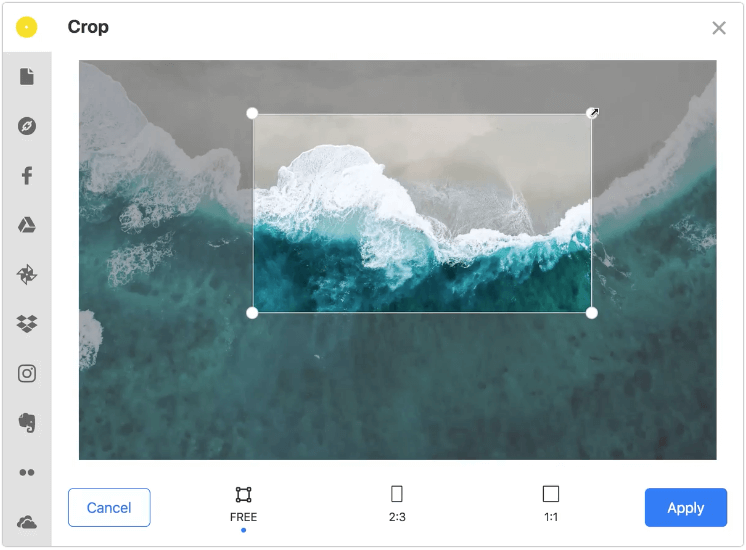 Uploadcare in-browser Image Editor and File Uploader
Uploadcare in-browser Image Editor and File UploaderImage intelligence and transformations
Computer vision is a complicated task, yet it’s been well researched and implemented by Uploadcare engineers. With it, you can automatically detect faces and recognize colors on your uploaded images, and the automatic object selection simplifies subsequent automatic operations and transformations.
For example, you can apply Automatic Face Blur (a similar technique is used on Google Maps Street View). Another example is the smart crop image transformation, which can crop full photos without cutting off important parts of the image (e.g., for creating profile pictures).
Fastest image resize
Other features needed after uploading are storage, delivery, and image transformations. Uploadcare features more than 80 image transformations and filters, but the most important one is a simple image resize.
Uploadcare features a super-fast image resize with the Python Pillow-SIMD engine. It’s used on almost every image to make it responsive on the web. That means that all website images will be delivered faster to all clients. Faster conversion is important because all images get processed upon request.
Uploadcare summary and pricing model
The name of the service is self-descriptive. It takes care of uploading your files with more options and features out of the box. Plus, you’ll feel the power of the entire pipeline to modify and deliver content to end users. Scalability is not a problem with its infrastructure and efficient file processing algorithms.
The pricing model is one of the simplest and most cost-effective on the market. Uploadcare’s image transformation is energy efficient and requires fewer servers to perform the same amount of operations. Therefore, you get limitless transformations, and prices are not tied to the number of image conversions, applied filters, etc.
Find a suitable plan for your business on the pricing page.
2. Sirv
Sirv is a solution for image uploading and delivery. The service offers tools for uploading, hosting, and managing pictures. Sirv offers some unique features like a 360° rotating image viewer and zoomable images. These features could be useful for online retail in particular.
It doesn’t have an uploader widget, so you can’t offer website users options to upload images on their own out of the box.
The web service has a nice GUI and it can be understood by an employee without much tech knowledge. Image URLs with sizes and transformations can be flexibly adjusted for specific needs without any coding.
Here are some of the strengths:
- URL transformation wizard (other services have transformations but no wizard)
- Image spin and zoom options
URL transformation wizard
A couple of the main strengths of Sirv are the URL wizard and the nice UI for URL image transformations. While image transformation is intrinsic to all the services in this comparison, Sirv does the best when it comes to exploring and using that feature to the fullest, thanks to the wizard.
It helps you generate a custom HTML image code for your specific task. You can select an image type (e.g., responsive image, zoom, or an e-commerce image set on the left-hand side), customize image settings, sizes, and filters on the right panel, and then just copy the code generated on the left. This is a very useful option that helps you configure links without spending time on learning API docs.
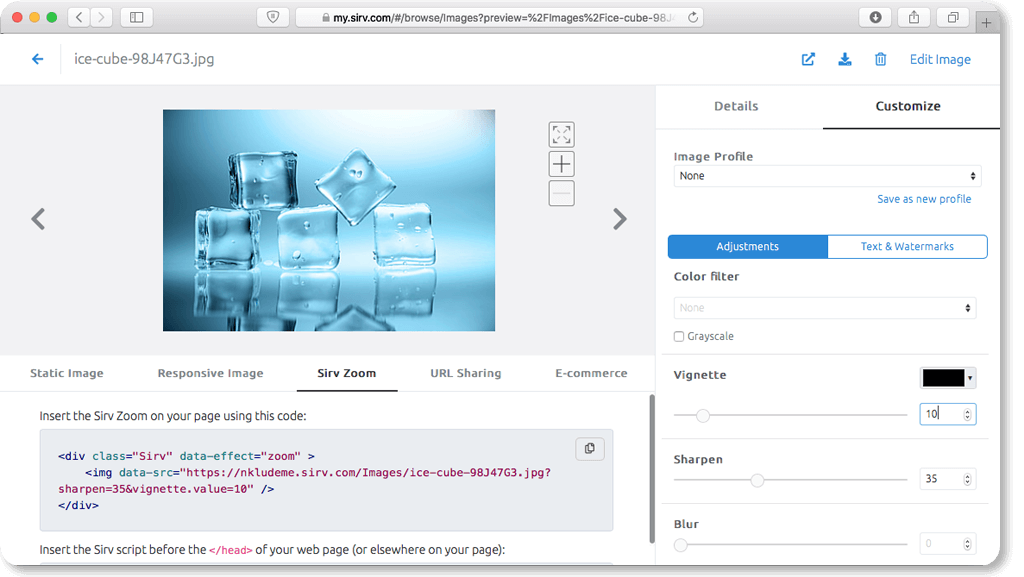 Interface of a URL transformation wizard
Interface of a URL transformation wizardSpin option
360° spin is another unique feature that gives a better spatial preview of an item. First, you need to feed a series of pictures made from different angles. Then, it combines those pictures into one movable interactive object. Dragging the mouse “rotates” the camera around. Also, you can save the sequence as an animated GIF without interactive elements.
You should have special studio equipment and establish a photo-taking workflow to use this feature to its full extent. Plan additional expenses beforehand for the photo and studio equipment.
Uploading profiles
The uploading manager supports profiles that you can create to perform batch conversions on uploaded files without any coding. It works more like a macro that you can set up and use later.
 Sirv profiles panel
Sirv profiles panelSirv summary
This service offers a lot for file uploading and management, and the website and UI are clear and sharp. If you don’t have user-generated content (no uploader) and don’t need some features like auto object recognition, give it a try and explore its neat options like the rotating viewer. This feature can help you create a unique e-commerce user experience with an online store.
3. Cloudinary
Cloudinary is a file uploader that focuses less on images and more on other file formats, such as video. It’s intended to be a centerpiece for all the media content that you might have on your website, including larger videos.
Here are a couple of Cloudinary’s strengths:
- Video processing and transformation
- Analytics
Popular development tools like jQuery, Python, Node.js, and PHP integrate with Cloudinary natively. Also, it supports these platforms out the box: .NET, Java, Rails, Django, Angular, React, Vue.js, Scala, iOS, and Android.
The system has a well-documented SDK, so you can use it from within the system or application you develop to use its image uploading and processing features.
Video transformations
The main differentiator here is that Cloudinary supports video transformations and on-the-fly video encoding. The other services can deliver videos too, but Cloudinary is a bit ahead in this department. The URL API for videos works pretty much the same way as for images, so you have your video tasks covered too.
You also have video filters, transitions (like in PowerPoint), and transparency masks. Plus, you can change video playback speed, make a looped video, or create a boomerang video clip.
Reports
Cloudinary reports provide lots of stats on overall performance and individual images. You can use the extensive report features for bandwidth, top images, most requested image formats, etc.
 Cloudinary reports
Cloudinary reportsAdd-on marketplace
Cloudinary provides face recognition in its stock solution but it doesn’t provide other advanced AI features. Complex operations that involve deep learning can be done with the help of third-party solutions (add-ons) that are developed by other companies with expertise in each particular task.
For example, if users of your service need to remove backgrounds from 3,000 images per month, you can pay an additional $150 for this particular feature.
Cloudinary summary
The pricing model for Cloudinary is somewhat complicated and not transparent. They use virtual “Credits” that stand for traffic, transformations (server processing power), and other parameters. You need to be very careful while selecting a plan, and it’s better if you know all the requirements and expected numbers beforehand.
Unlike the first three, the remaining two solutions are created for developers only, so it’s a bit like comparing apples and oranges (or maybe more like bananas and plantains). However, they offer file and image uploading and handling features as well, so let’s briefly explore what’s there.
4. Filestack
Filestack is aimed at developers who create applications and web systems. The whole Filestack experience starts with generating an API key. It’s not suited to be used by business owners without an IT department, because it doesn't have a user interface like Uploadcare and similar systems.
Despite the fact that it’s a developer-centric system, it comes with essential UI modules, and one of them is a file uploader.
File picker
Filestack features an uploader widget called File Picker with a nice UI and 20 uploading sources. It works on desktop browsers and mobile devices, and you don’t have to develop the uploader on your own.
Another component with a UI is an image editor that you can put on your webpage and let your users apply filters, adjustments, etc.
 Filestack's File Picker interface
Filestack's File Picker interfaceYou can integrate your Filestack file uploader with popular cloud services like Box, Dropbox, Facebook, Instagram, Google Drive, OneDrive, and a few others. Also, you can access these services by means of OAuth via the Filestack Cloud API.
Moreover, you can select your own custom source from the Amazon S3 bucket.
Content ingestion network
Filestack has its own unique feature called a Content Ingestion Network. It works similarly to the uploading CDN by Uploadcare. The file that you (or an end user) upload gets to the closest ingestion point where the link is created even before the file is finished uploading. Even if the file location changes, this link will remain intact for the user. This behavior is similar to Dropbox, where you get the link before the file is uploaded.
The system also takes care of issues such as an interrupted connection: the file will continue uploading when the connection is established again.
Documents
Filestack has built-in viewers for PDF files, PowerPoint presentations, Word and Excel files, and even Adobe Photoshop and Illustrator projects. You can embed these viewers into your website as an iframe.
Another document-oriented feature is Optical Character Recognition, which comes with the service, and if your website accepts lots of scanned documents, this might be a great feature.
Filestack summary
You can use your own hosting and use Filestack as an uploading/management service only. The uploading process itself can also be a complicated task even if you have your own hosting.
The security of the system to which users may upload files is of the highest priority. Thanks to the built-in virus checker, your system is protected.
Filestack’s pricing is based on processing traffic, and you can have your own hosting plan. These parameters will affect the plan price: Amazon S3 source integration, security, copyright detection, storage aliases, etc.
5. Transloadit
This image uploading and handling solution is created specifically for developers. It lives on GitHub, and if you have an account, you can just complete a single sign-on to the Transloadit website. The developers of this system offer a free JavaScript library called Uppy, which you can use in your project, or fork it on GitHub.
The service works with images, video, audio, and documents. Also, it includes audio and video encoding, image transformations, and content delivery.
Modular structure
The folks at Transloadit call their separate program modules “robots.” The service is built around custom workflows to suit any development task and custom file processing pipelines. There are robots for everything: image uploading, resizing, thumbnail extraction from videos, Dropbox integration, and many more.
 Transloadit image resize module
Transloadit image resize moduleTransloadit works out of the box, but you’ll definitely need to spend some time selecting the components you’ll need for your task so you don’t pay for components you don’t need.
Media modules and security
In addition to transcoding and transformations, the service can intelligently detect and fix incorrectly rotated videos. Also, it offers some video compositing features such as creating a video from a set of images or embedding audio (like on Coub.com).
A nice feature for a music service would be waveform generation, which visualizes an audio track’s waveform (like on SoundCloud).
Transloadit also features a virus detection feature for all uploaded files to secure your systems and infrastructure.
The Uppy uploader by Transloadit can detect faces, which is a great feature for profile pictures.
Transloadit summary
You can start with its free Uppy file uploader and your own hosting. If you need a more complex solution, select the modules (robots) you need to solve your business tasks and check out how this service works for you.
Summary
Every service among the above mentioned is a great option and is vastly better than having no file handling service at all. Select the optimal solution that solves your tasks well, and is scalable, understandable, and easy to integrate. Evaluate their customer support and pay attention to the website materials, because you’ll need to interact with them to use the service.
Prices and plans
Prices and plan details may be confusing to compare, so this article doesn’t include any numbers, because they may change, and every vendor has its own pricing policy and charges for things that others may not charge for. If you want to have a close-up look, we recommend that you visit the individual pricing pages for every service that interests you.
One of the main steps you need to make even before trying out these services is to determine the tasks and scale of your business. The common factor that influences costs is traffic for your service: for example, prices for a small website and large online store may differ a lot. Another component is hosting: most of the services do offer their own hosting and CDN. The third component is transformations; however, Uploadcare doesn’t include this parameter to calculate the price.
In short, determine your requirements — the closer the better. Test out the systems you like, and contact their sales departments for a custom pricing plan or to help you pick the closest plan from their existing ones to solve your file uploading and adjacent tasks.
Disclaimer
This article is the result of one person’s research and it may contain errors. If you use (or represent) any of the above-mentioned services and found a mistake in feature analysis, please let us know, and we’ll be happy to fix it! Price policies and feature sets change over time, so we recommend you take this text as a basic starting point for further investigation.